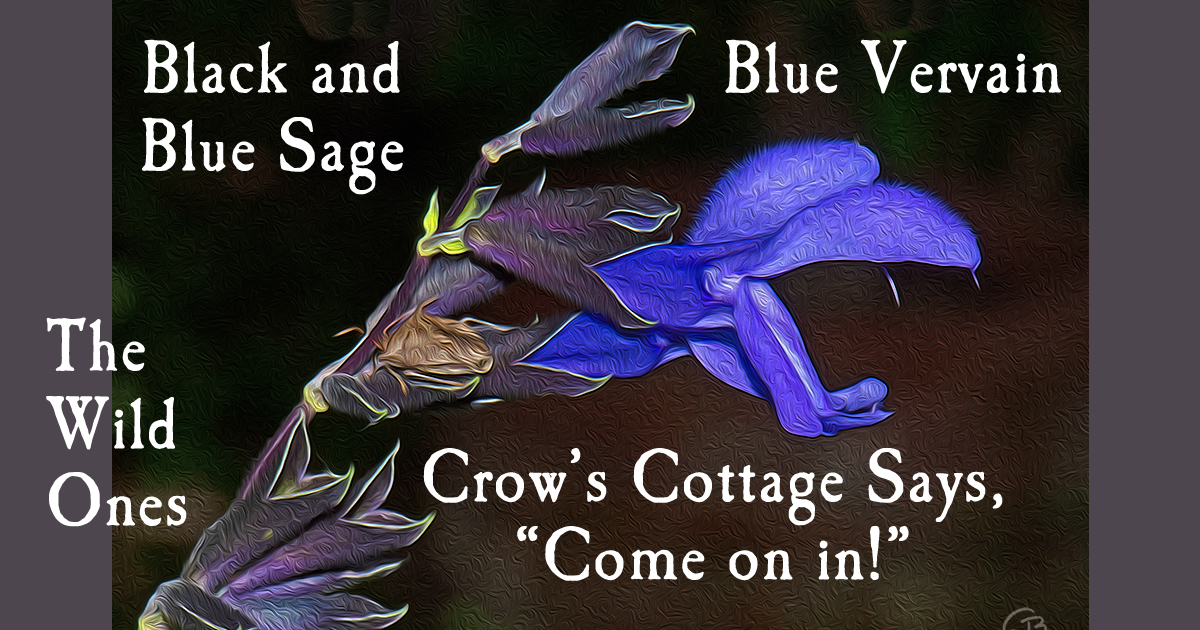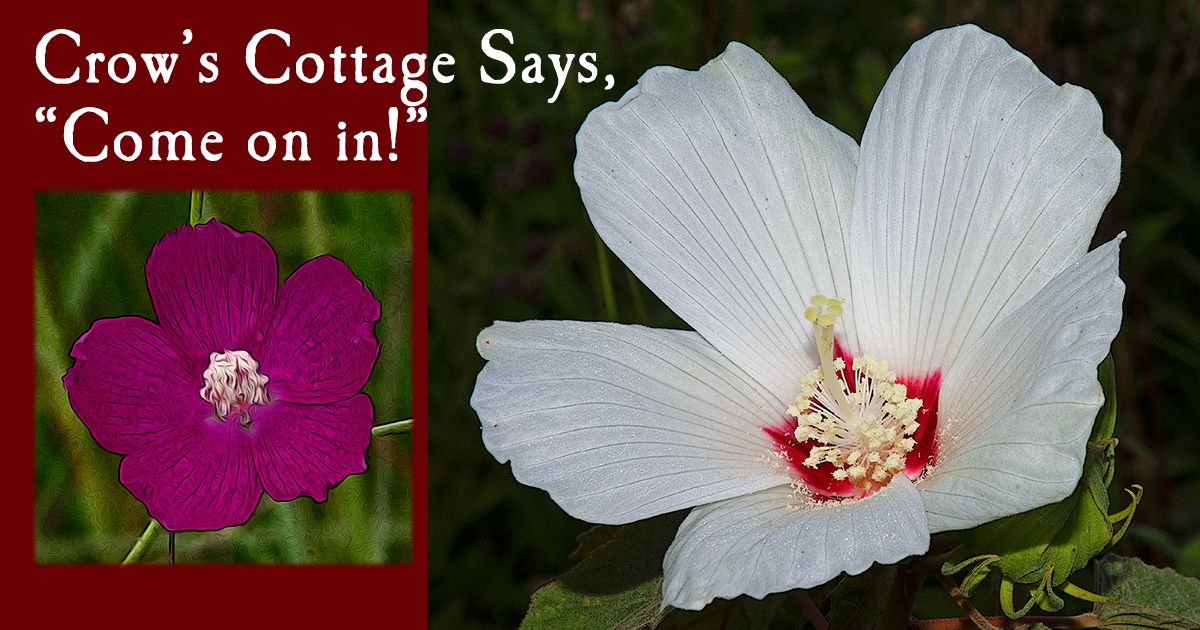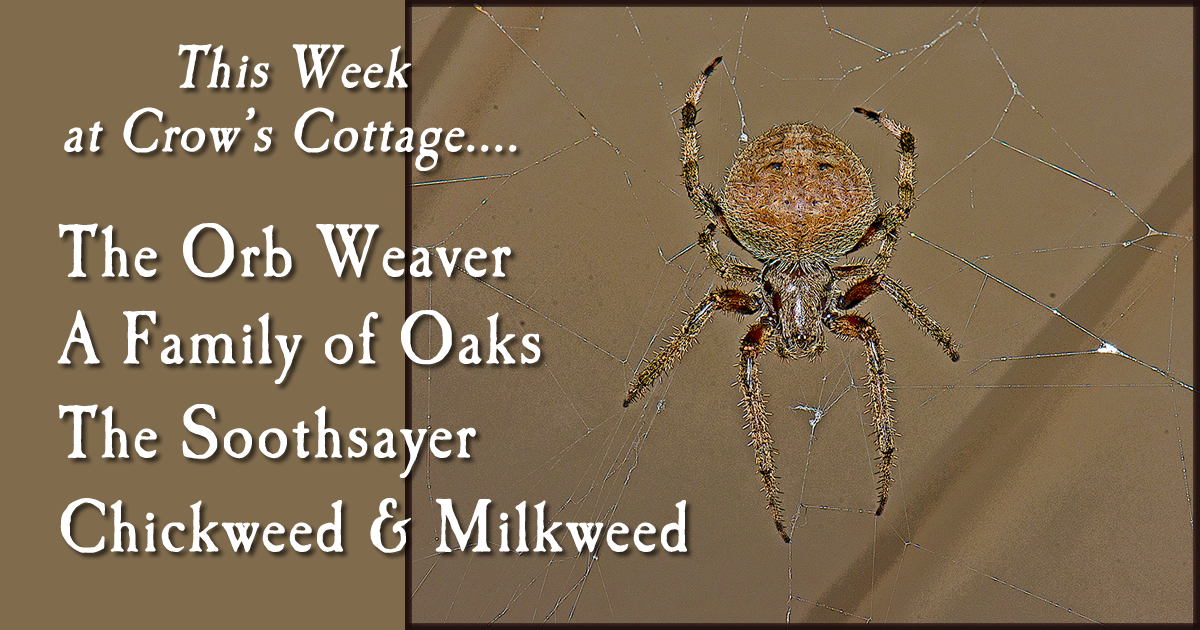

3 Dog Acres | rural Washington County, Arkansas
Image by Ebenezer | Summertime 2019
Pearly Eye
Trying to identify this beautiful critter led to a mishmash of possibilities as I sought help from the experts … and got more than I bargained for. Every expert agreed she's a Pearly Eye — a perfect common name for this butterfly, and all we really need to know — but curiosity rules. So, beyond the singular, commonplace fact of “Pearly Eye,” I tumble into the realm of supposition. My studies yield six choices:
Lethe anthedon
Enodia anthedon
Lethe portlandia
Enodia portlandia
Debis portlandia
Hipparchia Andromacha
Northern Pearly Eye aka Lethe anthedon is the name I select after much study — too much — of arcane botanical matters. We know that Anthedon was a village in Boeotia in ancient Greece. Lethe in Greek leads us into concepts of oblivion and forgetfulness, thus my sense of urgency to nail this down before I forget what brought me here in the first place.
Confusion abounds as I search deeper. For one, the Northern Pearly Eye is also identified as Enodia anthedon, opening an ancient gateway leading to a primal crossroads, and by inference to Hecate, a mysterious figure you probably wouldn't want to meet at any crossroads. For two, the species name portlandia has no obvious Greek connection — Portlandia in pop culture is a TV show — but nonetheless the Southern Pearly Eye is identified as Enodia portlandia by some, Lethe portlandia by others. Most of the time I can dig deep and find my way to a sensible solution, but not this time. I'm baffled.
More? OK. The Indiana Department of Geology and Natural Resources employed the name Debis portlandia in an 1892 publication. Good luck with a search for the meaning of debis.
And here's the kicker: the prominent naturalist Philip Henry Gosse, in his 1859 book Letters from Alabama, referred to the Pearly Eye as Hipparchia Andromacha — and yes, he capitalized the A. What's an amateur naturalist to do? Pick one and get on with it.

Beyond taxonomy, the Pearly Eye is a pugilist who prefers to hang out at the base of old trees and doesn't mind hand-to-hand combat … or better said, foreleg-to-foreleg combat. Professor Gosse in Letters from Alabama writes about the Pearly Eye:
It is interesting from its social and gamesome habits. A particular individual will frequent the foot of a particular tree for many successive days, contrary to the roaming habits of butterflies in general. Hence he will sally out on any other passing butterfly, either of his own or of another species; and, after performing sundry circumvolutions, retire to his chosen post of observation again. Occasionally I have seen another butterfly of the same species, after having had his amicable tustle, take likewise a stand on a neighbouring spot; and after a few minutes rest, both would simultaneously rush to the conflict, like knights at a tournament, and wheel and roll about in the air as before. Then each would return to his own place with the utmost precision, and presently renew the 'passage of arms' with the same result, for very many times in succession.
On the Nature of Eyes
On last observation: The striking false eyes painted by nature on the wings of the Pearly Eye are designed to trick predators, especially hungry birds, who apparently don't like big black eyes staring back at them. What strikes us in the image above are the three blue, curved bands of the Pearly Eye's actual eye. O, the mysteries!
Insect eyes were an object of fascination to the nineteenth century naturalist Bernardin de Saint-Pierre. Writing in his masterwork, Studies of Nature (1836), Saint-Pierre compares the vision of an insect with the vision of a human aided by a microscope. “Nay, their eyes are inconceivably superior even to this instrument; for it shows us objects only which are in its focus, that is at the distance of a few lines; whereas they perceive, by a mechanism of which we have no conception, those which are near and those which are far off. Their eyes, therefore, are at once microscopes and telescopes.”
“The world is full of eyes, and sight is everywhere. But there is a special category, another kind of eye that is neither real (like my eyes) nor metaphorical (like the 'eyes' of rainbows and halos),” James Elkins writes in The Object Stares Back: On the Nature of Seeing (1997). “It sees, and yet it is blind. I mean the fake eyes that some insects grow on their bodies in order to frighten away predators. Butterflies and moths tend to have these eyes on their lower wings, so that they can keep them hidden under the upper wings until they need to flash them in some animal's face. The effect startles practically any animal that can see: it keeps away birds, lizards, frogs, and small mammals, and it also scares many people. So many animals are frightened of eyes that biologists have a word for it — cyclophobism.” What, we wonder, is the power of The Third Eye for humanity? What might we see should one arrive at the place where we meet the Great Mystery? Where is the locus of fear?
The Butterfly Babies' Book (below) by Elizabeth Gordon and illustrated by M. T. (Penny) Ross. Published by Rand McNally & Company of New York in 1914.


The Great Wall of Privacy
Thick, Green and Lasting
By Ebenezer Baldwin Bowles
1 July 2020
Summer arrived with the Solstice. That was ten days ago, the year's longest day, and already the sunfall is arriving earlier — minute by minute. It just doesn't seem that way.
The green wall between our study window and the little lane out front hides us from curious eyes while allowing us to stay attuned to the seasons. Ambient sunlight drifting in from the east provides a sweet treat. At 13x5 feet, the window offers a grand view, but shielding a 65-square-foot surface from the outside world is a challenge, especially if one doesn't care to close the blinds.
Close the blinds we won't … not until the leaves fall away in Autumn. A gift of nature it is, the green wall. We appreciate it very much.
Not a wall in the typical sense, the green wall is a congregation of bushes, grasses, and trees designed to impose privacy via landscape.
A Very Large Holly
The wall begins up front next to the lane with a cluster of tall ravenna and giant miscanthus grasses, a mature button bush, three spirea, a pair of forsythia, and a huge old American holly, Ilex opaca. The tree trimming crew last May, working on behalf of the electric company, said ours is the largest holly they've ever seen. The cardinal birds love it. And the tree trimmers acted with great care when removing holly foliage from the high wires.
The next level includes three mature Leyland cypress trees — gathering places for songbirds — a Yoshino cherry, a ginkgo, a red maple, a redbud, a bridal wreath spirea, a large eastern red cedar, a flowering quince, three roses of Sharon, and a pair of lilacs. The Leylands are a miracle of sorts, having survived an attack from vicious forces under the name Seiridium canker six or seven years ago. Treating them with an antidote made all the difference to their survival.
Grandfather Oak Rules the Roost
Standing tall and wide in the center of it all is Grandfather Oak, ruler of the informal arboretum. By right of age and power, Grandfather decides who can stay and who must go beneath his spreading bower. During the decade past, many an understory tree or bush did not meet Grandfather's approval and passed away. However, we think the present arrangement is to his liking, especially the ginkgo, which has survived four years now in a place where other species have died. Thank you, Grandfather.
The last line of the privacy wall, the one closest to the hacienda, includes a pink dogwood, a golden raintree, a paw paw, two silver maples, a tulip poplar, the electric white pine, a nannyberry viburnum, grandmother oak and her family of flute bamboo, a Kwansan cherry, a second pink dogwood, and two more redbuds. It's quite the sight to see.
The electric white pine earned her nickname seven years ago when I attempted to plant her a few days after Christmas. Digging deep, I struck the electric line leading from the power pole to the hacienda. To my great fortune I nicked the line just enough to block the steady flow of power but not enough to be electrocuted. After the electricians replaced the line up to code, I planted the white pine in the intended spot. She and the tulip poplar, standing side-by-side, are having a race to see who can grow the tallest. The poplar is ahead by five feet or so.
Another Green Wonderland
On the north side of the driveway, also blocking sightlines from the lane to the study window, lives another little green wonderland. A tall black cherry stands next to three healthy stands of ravenna and a clump of pampas. There's also a thick blast of giant miscanthus, a river birch, two weeping willows, a pair of crepe myrtles, a forsythia, a walnut tree, a struggling bodark, and the aged apple tree.
Together these plants create The Great Wall of Privacy. Some are “native.” Others are not. Taken together or one-at-a-time, these silent living creatures provide a profound source of comfort in a world gone mad.

Woolsey Wet Prairie | Fayetteville, Arkansas
Image by Ebenezer | 16 August 2019
Rattle the Ephemeral Seedbox
At first it appears to be two flowering plants, one yellow and the other red. We've puzzled over the apparent duality, arriving without full confidence at the conclusion that the yellow blossom is the ephemeral Seedbox flower — that's for sure — and the red flower is actually no flower at all but rather a set of sharply pointed leaves on the reddish Seedbox stem, lance-shaped leaves that should soon turn a deep green color over time. That's what we believed to be true until we heard from naturalist extraordinaire Eric Fuselier, who writes: “I believe the four red petal-like structures you are seeing are the bracts of the flower, after the petals have fallen away.” Thanks, Eric.
But look quickly. The yellow Seedbox flower, much like its cousin the Showy Evening Primrose, lasts but a single day. Blink your eyes and she's long gone.
There's no end to the story of any individual member of the great world out there — the realm of flowers, trees, insects, birds, and all sorts of animals, vegetables, and minerals who grace our world. We welcome the sometimes exasperating, always rewarding process of learning about the species that come our way. The Seedbox is extra interesting because she's absolutely beautiful.
We like best of all the name Seedbox, though the name Rattlebox is acceptable. We also like Floating Primrose Willow, a name seldom employed but easy on the ear. When pioneering botanists were scouring the countryside at the beginning of the Age of Scientific Method, this pretty flower in 1753 was given the name Ludwigia alternifolia. Ouch! It is an honorific aimed at Christian G. Ludwig (1709-1773), a well-known German botanist who never set foot on the North American continent.

Let's Drop the Bastard, Please.
In Ludwig's day this little beauty was known amongst amateurs as the Common Bastard Loosestrife. A hundred years later in his 1868 textbook Gray's Lessons in Botany and Vegetable Physiology, the pioneering Harvard educator Asa Gray dropped the bastard in favor of the False Loosestrife. Sometime between now and the late nineteenth century, our little flower acquired the common name of Seedbox.
One tiny seedbox, botanists claim, will produce one million, three hundred thousand seeds per ounce! When we checked today, an outfit on the Internet was selling themselves short, claiming one pound of Seedbox seeds yields four million, five hundred thousand seeds at a price of 175 U.S. dollars — whereas 16 ounces at one million, three hundred thousand per ounce = twenty million, eight hundred thousand seeds. Bottom line: Who's counting? And what might someone do with so many millions of seeds?
There's a common point circulating through this mini-essay and others here at Crow's Cottage: over time knowledge is fluid, fashion and personal tastes even more so, and none of it matters if you're having fun. The seedbox flowers are blooming now and shall continue to do so through August.
Closing facts: the Seedbox prefers marshes, wet meadows, and swamps, which fits our experience. The specimen shown here lived at Woolsey Wet Prairie in Fayetteville, Arkansas — a wetland if we've ever seen one. And, after the four delicate petals fall away, the box-like seed capsule, millions upon millions, will rattle when shaken … shake, rattle, and rock ’n roll.

Islands of Hope in a Warming World
A weather station in the Siberian town of Verkhoyuansk, north of the Artic Circle, recorded a temperature of 101 degrees Fahrenheit on June 20, the highest temperature ever recorded in the Arctic … On the other “side” of the globe at the South Pole, scientists found that between 1989 and 2018 the temperature warmed by about 1.8 Celsius, three times the global average … Canada has launched a project to plant two billion trees in 2020 … In England, an effort to tackle climate change aims to plant 74,000 acres of new woodland over the next five years … In India, the Ministry for Environments, Forests and Climate Change launched a program to develop 200 urban forests over the next five years.



Black Gum, Morning Glory, Lucky Clover
3 Dog Acres | rural Washington County Arkansas
Image by Ebenezer | late summer 2019
They say the fourth leaf of a lucky clover is a tad smaller than the other three. If so, the fourth leaf in this image must be the one to the bottom right, which does look smaller. Barely. Leaf No. 1 = faith. Leaf No. 2 = Hope. Leaf No. 3 = Charity … another way of saying Love. And leaf No. 4 = good luck. To our dismay, the search for four-leaf clovers is faltering this growing season. We've found but two. This time last year we'd found a half dozen or more, including one five-leaf clover. They say the betting line on finding a four-leaf = ten thousand to one. Trifolium repens, the white clover, provides the lucky charms, leaving the red clover, Trifolium pratense, the odd man out.
The leaves from the Black Gum (Nyssa sylvatica) wear their deep green summertime color, but come autumn they will transform into a wine-dark and golden beauty. Few deciduous trees can match the autumnal drama of a mature Black Gum. Our specimen, a youngster of four or five years, standing about ten-feet tall, hasn't made fruit yet, but we hear the birds love it. We've also planted (in pots) ten Black Gum saplings supplied by the George O. White State Forest Nursery in Licking, Missouri — but frankly, they aren't doing so well. We'll know by summer’s end whether or not they will be viable for the growing season of 2021.
As for the morning glory, we display her in the Camera Eye for no particular reason other than because we consider this species to be amongst the most beautiful of flowers — and because we won't be seeing any morning glories this summer or fall unless 2019's seeds decide to volunteer for another go ’round. We're a bit sad because we've neglected to plant seeds for this growing season — and now it's just too late.

The Closest Thing to Eternal
Can you guess which critter is Planet Earth's longest-lived vertebrate? Or how long? Answer: the Greenland Shark. 512 years old — give or take a decade or two. So writes Katherine Rundell in the London Review of Books of 7 May 2020. Scientists using radiocarbon dating on 28 female Greenland Sharks contend the lifespan ranges between 252 to 512 years. “It's very possible that there are sharks in the water today who are well into their sixth century,” Ms. Rundell writes. “These slow, odorous, half-blind creatures are perhaps the closest thing to eternal this planet has to offer.”
So what? ask the trees. A Great Basin bristlecone pine in the White Mountains of California is 4,851 years old — at that age he deserves a name. Can you guess? Try Methuselah and you'll be right. We humans are way behind. Our oldest at 122 years was Jeanne Calment of France, who passed away in 1997.


3 Dog Acres | rural Washington County, Arkansas
Image by Ebenezer | 25 July 2019
Sing Me a Love Song
When Katydids are involved, the immediate attention goes directly to song, scientific term stridulate = the act of producing sound by rubbing two body parts — front wings in this case — together. Our specimen was resting on a seating pad at Doghenge midday and kindly allowed us to take her picture before she flew away lickety split — they say the katydid is a strong flyer and likely to escape a looney botanist with a net.
“The Katydid is one of the most conspicuous Grasshoppers of North America,” Benedict Jaeger wrote in The Life of North American Insects (1859). “In the cool evenings of autumn its melancholy song reverberates from every tree in our orchards and forests, and its never-ceasing complaint, that Katy did, has not only suggested a thousand pleasant recollections, but has often occasioned many curious and poetical conjectures as to its origin and significance. I use the word significance in its most extended sense, for I know no thing in nature that is insignificant. Every voice, every sound, each warbling note that echoes in the empty air, and every act of animated nature, has some deep, often mysterious meaning. To the thoughtful mind all convey some important moral lesson, either in the garb and soul of poetical association, or by the stronger and more irresistible force of example.”
Professor Jaeger continues: “So each animated atom of creation bears the stamp of some great moral or intellectual significance, and appeals alike to the poet's enthusiasm, the naturalist's all-absorbing love of nature, the philosopher's burning desire to penetrate hidden mysteries, and to man's universal and unborn conviction that naught was ever made in vain.”
Our specimen is Amblycorypha oblongifolia, the oblong-winged Katydid. Where she fits into the grand scheme of grasshoppers, crickets, and other Katydids we can't know for certain. Nor do we have to know. We are happy enough to hear that a Katydid's chirps might sound like a Jacarilla Apache love flute. Or that a Katydid in New Age lore can teach us how to tune-in to new vibrations and enhance intuition, sensitivity, and awareness. Or just marvel at the creature before us.
Professor Jaeger, the poet-philosopher-naturalist of the nineteenth century, asks us to attune our stridulated powers toward Miss Katy, who sat with her lover beneath the moon-lit bower of love and later wondered what the creature might have heard. Every word, he said, and then spoke to her in rhyme.
But never fear me, gentle one, nor waste a thought or tear,
Lest I should whisper what I heard in any mortal ear;
I only sport among the boughs, and, like a spirit hid,
I think on what I saw and heard, and laugh out ‘Katydid,’
I see among the leaves here, when evening zephyrs sigh,
And those that listen to my voice I love to mystify;
I never tell them all I know, although I'm often bid;
I laugh at curiosity, and chirrup ‘Katydid.’











As always, we invite you to write us letter of encouragement or correction. You can even chastise us if you're respectful. Expect a courteous and timely reply. And let us know if you'd like to receive a notice about new features. Our address is ebenezer@crowscottage.com





